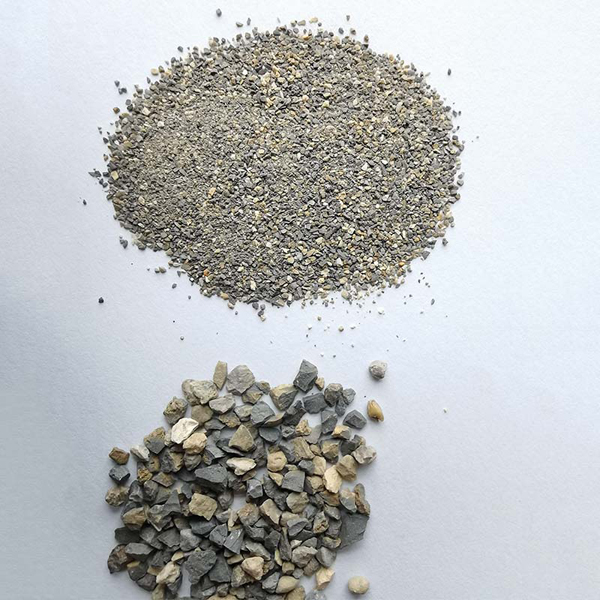Alumina is mainly extracted from bauxite by the Bayer process, in which caustic soda material is used in combination with heat and pressure to dissolve the aluminum-bearing minerals in the bauxite.
Calcined (or alpha) alumina is made by roasting the source alumina powder at 1200-1300C to convert it to pure Al 2 O 3 (when calcined near 2000C, large hexagonal, elongated lamellar crystals form "slab alumina"). alpha form is the densest and most stable crystalline form of alumina.

Calcined Bauxite
Alumina is produced from bauxite, an ore mined from topsoil in various tropical and subtropical regions, and the Bayer process, discovered in 1887, is the main process for extracting alumina from bauxite.
Calcined alumina is an aluminum oxide that has been heated at temperatures in excess of 1,050 °C (1,900 °F) to drive off almost all of the chemically bound water. In this form, alumina has a high chemical purity, very high hardness (9 on the Mohs scale versus ...... for diamond)
Calcined alumina is generally used in the manufacture of high-grade ceramic profiles, refractory materials and electrofused alumina abrasives. It can be compressed to produce a firing density of 3.8 or higher... Manufacturing methods and glasses vary depending on the application.
Skin contact: No known significant effects or serious hazards. Ingestion: No known significant effects or serious hazards. Reactivity: None under normal handling. Chemical Stability: This product is stable at room temperature under normal storage conditions in a closed container.
Aluminum oxide or alumina trihydrate obtained by the Bayer process is calcined at temperatures above 1200°C and up to 1600°C to produce special grades of alumina. During calcination, the hydrated alumina crystals lose their bound moisture and recrystallize to form alumina crystals.
Fire-resistant bauxite, also known as calcined bauxite, is produced by sintering raw bauxite at temperatures above 1500°C... Calcined bauxite therefore has a high aluminum content and a low impurity level, which makes this raw material particularly heat resistant.
Alumina hydrate (ALHYD) is preferred to the calcined form in glazes to improve the quality of binders and suspensions. It is commonly used as a kiln wash in salt fire operations and as a crack reduction aid.
Activated alumina powder is an essential component of high-quality refractory products, including fine ceramics and cast refractories. Benefits of using activated alumina: Reduces water requirements. Produces low porosity refractory products. Provides excellent sintering reactivity.
Alumina is a compound containing the chemical element aluminum. Therefore, the main difference between aluminum and alumina is that aluminum is a chemical element, while alumina is an aluminum-containing compound.
In the Bayer process, bauxite is heated in a pressure vessel with a solution of sodium hydroxide (caustic soda) at temperatures between 150 and 200°C. The bauxite is extracted from the bauxite at a temperature of between 0.5 and 0.5°C. At these temperatures, the aluminum dissolves into sodium aluminate (mainly [Al(OH) 4 ] - ) during the extraction process.
White corundum is a high purity synthetic mineral made by melting controlled quality pure grade Bayer alumina in an electric arc furnace at temperatures above 2000 o C followed by a slow solidification process.
Pain during urination; muscle weakness, fatigue; extreme drowsiness; or. Bloody or tarry stools, coughing up blood or vomitus that looks like coffee grounds.
Aluminum Oxide (OA) is the most widely used oxide ceramic material. It is used in a wide range of applications, including spark plugs, faucet washers, wear-resistant tiles and cutting tools. A very large tonnage is also used in the manufacture of monolithic and brick refractories.
Hydrated alumina treated with aqueous NaOH solution? Alumina dissolves in aqueous NaOH solution to form sodium meta-aluminate.
Calcined bauxite is produced by sintering high alumina bauxite at high temperatures in a rotary kiln, round kiln or vertical kiln. This process of calcining (heating) the bauxite in the kiln removes water and gives the calcined bauxite its high alumina content and refractoriness, low iron, and grain hardness and toughness.
Copyright © Hebei Jufuyuan Trading Co., Ltd. All Rights Reserved | Sitemap
E-mail: info@jufuyuan-s.com
Mobile: +86 137 3119 7671
Skype: seansu9
WhatsApp: +86 137 3119 7671
QQ: 369706292
Add: 2-2-707 Caifutianxia Tieyuan North Road Shengli North Street, Shijiazhuang City Hebei China